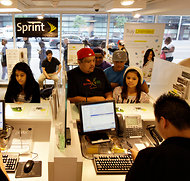But the fuel cell technology — which promised efficient, cleaner and increasingly inexpensive “energy in a box” — intrigued him. After several more visits, Mr. Son was convinced that Bloom’s sleek fuel cell servers were a perfect fit for Japan, energy-poor and made even more so by an almost complete shutdown of its nuclear energy program after the 2011 Fukushima disaster.
Now, SoftBank, the $70 billion Japanese technology investment company that completed its acquisition of Sprint Nextel this month, is setting up a joint venture with Bloom to bring its energy servers to Japan, helping the start-up break into its first overseas market.
The deal adds yet another piece to SoftBank’s fast-growing Internet, mobile communications and technology empire, which increasingly straddles Japan and the United States. It also adds fuel cell technology to SoftBank’s alternative energy portfolio, which already includes solar and wind projects, bolstering its position as an emerging player in electricity generation in Japan.
“He is a crazy guy, but in a good way. He’s crazy enough to want to completely change the way people live,” Mr. Son said of Bloom’s co-founder and chief executive, KR Sridhar, in a joint phone interview from California early Wednesday. “I’m not looking to get into the electricity business with traditional technology.”
The two companies said they would initially invest $10 million each in a joint venture that would sell Japanese corporations electricity generated by fuel cells, a substantially cleaner and more efficient source of energy than coal or other fossil fuels. Though the venture will focus on Japan for now, it could eventually look farther afield to markets like China, Mr. Son said.
The venture’s biggest selling point is that its fuel cells, placed within a corporation’s own grounds, offer an alternative to using the national power grid. In Japan, that would help companies avoid rising electricity bills. Power companies here have been raising prices to pay for increased fuel imports to make up for their shuttered reactors. Nuclear power generated almost a third of Japan’s electricity before the 2011 tsunami put a major reactor out of commission and caused the Japanese to reconsider running other reactors.
Fuel cell technology complements SoftBank’s other renewable energy projects, Mr. Son said, because it would provide a stable level of electricity to help offset fluctuating power output from solar or wind. SoftBank turned its attention to clean energy after the Fukushima crisis, and has been investing heavily in solar power farms across Japan.
Mr. Sridhar said Japan would be able to better buttress itself against natural calamities by replacing centralized power generation with local energy servers. They are unlikely to be all wiped out at once, and are more rapidly and easily replaceable, he said.
“When you have centralized infrastructure, and a major event like a tsunami happens and the infrastructure happens to be hit, it affects the whole region, the whole country,” Mr. Sridhar said.
“But when you distribute the power, you distribute the risk, too,” he said. “And electricity becomes personal.”
For Bloom, which has spent over a decade developing a new variety of fuel cell, the new foreign venture comes as a welcome validation of its technological potential. The Sunnyvale, Calif., company has raised more than $1 billion in venture capital financing, including early investments from Silicon Valley powerhouses like Kleiner Perkins Caufield Byers, and produces power for a range of companies, including Apple, Google, Walmart and Coca-Cola.
The venture could also open up lucrative new markets, just as falling natural gas prices make fuel cells more economically competitive with grid power.
Fuel cells, which convert natural gas, hydrogen or another fuel into electricity with no burning or combustion, have long offered the promise of cleaner, more plentiful energy. But the need for expensive materials like platinum in fuel cells kept costs high and shortened their longevity.
Mr. Sridhar, a former NASA scientist, learned to make the devices from common materials that will last longer. For example, Bloom’s fuel cells use a thin ceramic wafer made from sand.
Still, Bloom and SoftBank could face increasing competition in their quest to take the technology global. In Japan, a handful of companies have also invested heavily in fuel cell technology and now provide smaller-scale fuel cell batteries for homes. Mitsubishi Heavy Industries, the industrial giant, is in the early stages of a government-sponsored project to develop large-scale fuel cell power plants.
The joint venture would seem to fill a gap between those two scales of generation in Japan, said Kazunari Sasaki, a fuel cell expert who heads the Next-Generation Fuel Cell Research Center at Kyushu University. And globally, an increasingly crowded field of fuel cell makers are set to compete along efficiency, cost and durability lines, he said.
Bloom appeared to have the edge, for now, in conversion efficiency, or how efficiently it converts fuel to electricity. The company said its systems provided over 60 percent efficiency at the beginning of their lives, declining to the mid-50s as they mature. Mr. Sasaki said that Japanese fuel cell makers tended to offer about 40 percent fuel efficiency.
“Bloom’s entry into Japan will certainly have a big impact on the industry here,” Mr. Sasaki said. “Over all, I see it as a positive that will spur more competition, investment and technological development.”

Article source: http://www.nytimes.com/2013/07/18/business/global/softbank-forms-fuel-cell-venture-with-silicon-valley-start-up.html?partner=rss&emc=rss
